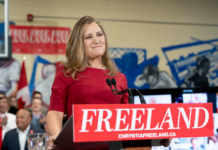Mortgage renewal rates in the coming years will result in price increases that many Canadians may struggle to stomach, according to the Bank of Canada’s most recent report.
The Bank of Canada’s 2024 Financial Stability Report highlights the average percentage increase in mortgage payments at the time of renewal compared with the price issued at the mortgage’s origination.
“The financial pressure will increase most for households that took out a mortgage in 2021 and early 2022 when house prices were close to their peak and mortgage rates were very low,” reads the report.
Homeowners who borrowed during that time took on large mortgages relative to their income, have seen little increase or even decreases in their home equity, and will see larger increases in payments at renewal, according to the Bank of Canada.
By 2026, Canadians who renew their mortgages that previously had variable-rate mortgages with fixed payments will see the largest increase compared to their previous mortgage’s origination, expected to rise 61.85%.
Payments are expected to increase by 31.88% among all types of mortgages by 2026. Those who will be hit with the softest increase are Canadians who previously held fixed-rate mortgages with a term of less than five years, who will see an increase of 19.26% by 2026.
Those who will be hit the hardest are homeowners who took out a mortgage between Apr. 1, 2020, and Mar. 1, 2022, when Canada’s prime interest rate was 2.45%. It is currently at 7.2%.
Increasing interest rates is a double-edged sword. For example, variable rate holders could have seen interest rates increase so much that they pay down only interest on their mortgage while making no payments on principal. Therefore, when they renew their 25-year mortgage at the 20-year mark, they have to make up for lost time when they made no payments to bring down the principal cost of the mortgage.
Making up for the lost time on principal payments and a new higher interest rate on their renewed mortgage could skyrocket homeowners’ housing costs.
“The share of income dedicated to mortgage payments — also called the mortgage debt service ratio — has been much larger for households that took on a mortgage after interest rates started rising in 2022 relative to households that took on a mortgage in prior years,” reads the study.
By the end of 2023, more than one-third of recently issued mortgages had a debt-to-income servicing ratio exceeding 25%. This figure has doubled compared to 2019. This increase has unfolded even as households have chosen smaller mortgage amounts in relation to their income and opted for extended repayment terms.
Canada’s debt-to-income ratio is the largest in the G7 despite households being second wealthiest.
Housing affordability reached an all-time low in April, according to an RBC report.
The average household in Vancouver has to spend 106.3% of its income to cover homeownership costs.
The Bank of Canada said that higher inflation and interest rates have increased financial pressure on household finances.
“Signs of increased financial stress appear mainly concentrated among renters,” reads the report.
Canadians without a mortgage who have fallen behind on credit card and auto loan payments have risen, returning to normal levels and even surpassing them.
The share of Canadians with arrears on credit cards for those without a mortgage was 2.22% in Mar. 2024, compared to only 1.05% for mortgage holders. 1.31% of Canadians without a mortgage had arrears on credit cards for auto loans, compared to only 0.2% of Canadian mortgage holders.
Households without a mortgage have increased their reliance on credit cards. As of Mar. 2024, 45.68% of Canadians without a mortgage carry an outstanding credit card balance. 23.03% of Canadians without a mortgage carry a credit card balance exceeding 80% of their borrowing limit.





















